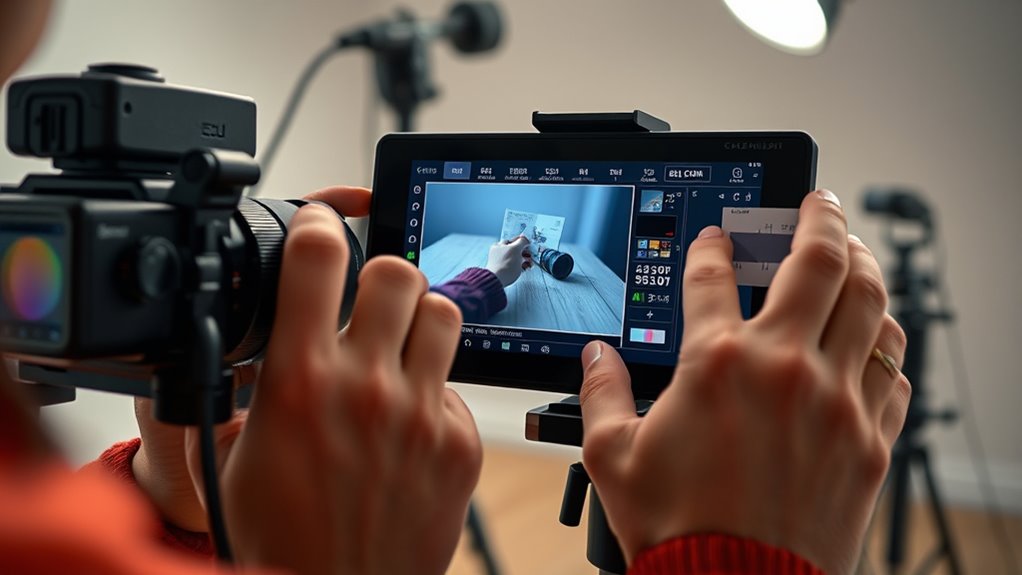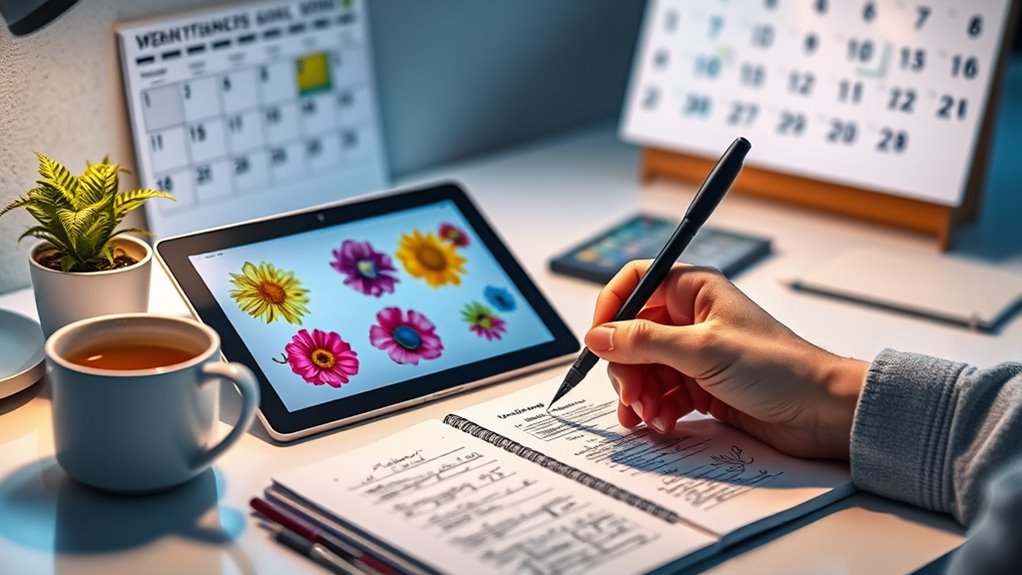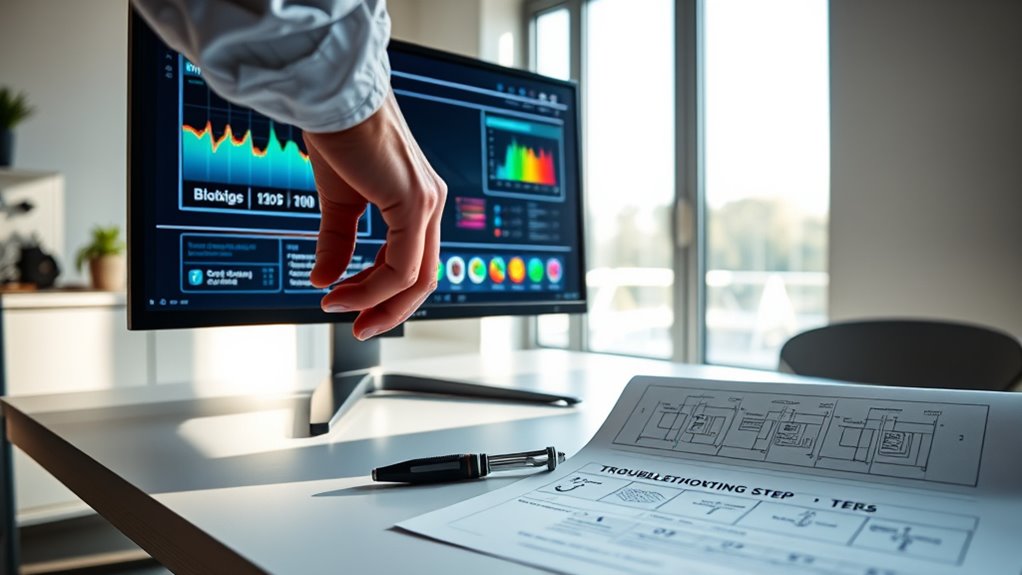To troubleshoot the Bloom technique quickly, start by checking your equipment calibration to guarantee accurate effects. Review each step carefully, avoiding rushed or uneven applications. Watch visual tutorials or guides to spot common mistakes like incorrect settings or lighting issues. Optimizing your workspace by organizing tools and reducing distractions also helps. If you’re willing to explore further, you’ll discover tips to refine your process and achieve better results more efficiently.
Key Takeaways
- Verify Bloom settings (intensity, threshold, type) for proper calibration.
- Ensure correct tool usage and proper tip size during application.
- Check scene lighting and ambiance to match Bloom effect requirements.
- Review process steps for correct sequence and smooth transitions.
- Use visual aids and community resources for quick troubleshooting guidance.
Check Your Setup and Equipment

Before troubleshooting the Bloom Technique, it’s essential to guarantee your setup and equipment are properly configured. Start by checking that your equipment is calibrated correctly; inaccurate calibration can lead to flawed results. Ensure all tools and devices are functioning smoothly, with no loose connections or damaged parts. Next, focus on workspace organization—an orderly area helps you identify issues quickly and prevents accidental mishaps. Keep your work surface clean and free of clutter, so tools are within reach and properly arranged. Confirm that your lighting is sufficient for precise adjustments. Proper setup not only improves accuracy but also minimizes troubleshooting time. When your equipment is calibrated, and your workspace is organized, you set a solid foundation for effective Bloom Technique execution. Additionally, understanding city dynamics can help tailor your setup to specific environments, ensuring optimal performance in various settings.
Review Your Technique Steps Carefully

Make sure you follow each step in the correct order and don’t skip any. Confirm that your timing is precise to avoid issues, and double-check that you’re using the right tools at each stage. Paying close attention to these details helps guarantee your technique is accurate and effective. Additionally, consulting retail hours today list can ensure that your shopping or service visits are well-planned and timely.
Check Step Sequence
Have you double-checked your step sequence to guarantee each movement aligns with the Bloom Technique’s guidelines? Confirming your steps follow the correct order is essential for proper Bloom adjustments and effective Technique calibration. Review each movement carefully, confirming that transitions flow smoothly and logically. Small deviations or skipped steps can cause misalignment and hinder progress. By meticulously verifying your sequence, you identify any errors early, allowing you to make precise corrections. This focused review helps maintain consistency and ensures your technique remains aligned with the intended principles. Remember, a well-structured step sequence is the foundation for successful Bloom Technique execution. Taking this extra time to confirm your order is a quick, impactful way to troubleshoot and enhance your overall practice.
Confirm Proper Timing
Ensuring proper timing is crucial for the effectiveness of the Bloom Technique, as even small discrepancies can disrupt the flow and impact of each movement. To verify proper timing, review each step carefully, paying close attention to the sequence and durations you’ve assigned. Focus on timing accuracy, making sure each movement occurs at the right moment and in the correct order. Process synchronization is key; all parts of your technique should work seamlessly together. If you notice any lag or premature actions, adjust your timing to guarantee smooth transitions. Consistent timing guarantees that your technique remains cohesive and impactful. Take the time to double-check your steps, as precision in timing directly influences the overall effectiveness of your performance. Additionally, understanding sound vibrations can help you better synchronize your movements with natural rhythms and frequencies for a more harmonious execution.
Verify Tool Usage
To confirm your tool usage aligns with your technique steps, review each movement carefully. Check that your tools are properly calibrated to guarantee accurate results and maintain user confidence. Misaligned or uncalibrated tools can lead to inconsistent blooms or damage to your work. Regularly inspecting your Vetted – Grobal World tools ensures optimal performance and longevity.
Identify Common Mistakes and Correct Them

You need to check for incorrect Bloom settings that might be throwing off your results. Sometimes, improper technique execution causes issues that are easy to overlook. Correcting these mistakes will help you get the most accurate outcomes from your process. Ensuring proper tip size selection and adequate filtration can also significantly improve your results.
Incorrect Bloom Settings
Have you ever noticed your bloom effects look off despite following the usual settings? This often happens due to incorrect calibration of your bloom parameters. Common mistakes include setting the intensity too high or too low, misadjusting the threshold, or using incompatible bloom types. These errors can cause overexposed or dull effects, ruining your visuals. To fix this, double-check your bloom settings and ensure they match the scene’s lighting. Avoid these pitfalls:
- Overly high bloom intensity
- Incorrect threshold levels
- Using incompatible bloom types
- Skipping calibration steps
- Ignoring scene-specific adjustments
Additionally, understanding the Best Beaches can inspire a fresh perspective on scene lighting and ambiance, helping you better calibrate your bloom effects.
Improper Technique Execution
Even with properly calibrated bloom settings, applying the technique incorrectly can still lead to subpar results. Common pitfalls include rushing the process, uneven application, or misplacing the bloom area. These mistakes hinder proper technique refinement and reduce effectiveness. To avoid these errors, focus on maintaining steady, controlled movements and ensuring even coverage. Pay close attention to your application angle and pressure, as inconsistent execution creates uneven blooms. Regularly review your approach and compare it to best practices to identify areas needing improvement. Remember, technique refinement is key—small adjustments can appreciably improve results. Incorporating precious metals investment strategies can also enhance your overall financial security. By avoiding common pitfalls and practicing deliberate, precise movements, you ensure your bloom technique performs at its best every time.
Use Visual Aids and Tutorials for Guidance

Utilizing visual aids and tutorials can substantially streamline the process of troubleshooting Bloom Technique issues. These resources provide clear, step-by-step guidance, making it easier to identify and fix problems quickly. By exploring visual guides and tutorial resources, you gain a better understanding of correct procedures and common pitfalls. They also help you visualize complex steps, reducing confusion and errors. To maximize their effectiveness, consider:
- Watching detailed video tutorials
- Following annotated diagrams
- Reviewing troubleshooting infographics
- Using interactive guides
- Accessing community-shared tips and examples
These tools serve as quick references, saving time and frustration while ensuring you perform the Bloom Technique accurately. Relying on visual aids and tutorials empowers you to troubleshoot confidently and efficiently. Additionally, understanding related concepts like Hyundai Tuning can provide valuable insights into vehicle performance adjustments.
Adjust Your Environment for Better Performance

Adjusting your environment can profoundly enhance your Bloom Technique performance by minimizing distractions and optimizing your workspace. Start by improving the lighting conditions—ensure your area is well-lit with natural light or soft, white bulbs to reduce eye strain and boost focus. Managing ambient noise is equally important; choose a quiet space or use noise-canceling headphones to block out distractions. Keep your workspace tidy, removing unnecessary clutter that might divert your attention. Consider the temperature and airflow, making sure they’re comfortable to help you stay relaxed and alert. Incorporating proper workspace setup can further improve your concentration and efficiency. By creating a calm, well-lit, and quiet environment, you’ll find it easier to concentrate and perform the Bloom Technique more effectively. Small adjustments here can lead to significant improvements in your results.
Practice Consistently and Track Your Progress

Maintaining a consistent practice schedule is key to mastering the Bloom Technique. When you track your habits regularly, you gain insight into what works and where to improve. Set clear goals to stay motivated and measure progress effectively. Consistent practice helps reinforce muscle memory and builds confidence. To optimize your efforts, consider these strategies:
Consistent practice reinforces muscle memory, boosts confidence, and reveals clear paths for improvement.
- Track your daily practice sessions to identify patterns
- Set specific, achievable goals for each week
- Use a journal or app to monitor progress
- Review your habits regularly to adjust your approach
- Celebrate milestones to stay motivated
- Regularly reviewing your goals and progress enhances personal goal tracking and ensures continued growth.
Frequently Asked Questions
What Are the Signs That My Bloom Technique Is Fundamentally Flawed?
If your bloom technique is fundamentally flawed, you’ll notice visual cues like uneven or patchy blooms and inconsistent application of pressure or timing. These signs suggest you’re not maintaining steady control or proper technique. You might also see irregular shapes or sizes that don’t match your intended pattern. To fix this, focus on consistent application and watch for visual cues that indicate where adjustments are needed, ensuring a smoother, more controlled process.
How Long Should I Practice Before Expecting Noticeable Improvements?
Imagine planting a seed; with consistent watering, you’ll see sprouting in a few weeks. Similarly, your timing expectations depend on regular, focused practice. Typically, noticeable improvements come after 2-4 weeks of consistent effort. Keep practicing daily, and don’t get discouraged if progress feels slow. Your dedication is like nurturing that seed—patience and consistency will bring your Bloom Technique to life.
Can Specific Environmental Factors Permanently Hinder Bloom Technique Success?
Environmental interference and poor soil quality can permanently hinder your Bloom Technique success if not addressed. You might notice that persistent environmental factors, like pollution or compacted soil, limit plant growth regardless of your efforts. To improve your results, guarantee your environment is free from interference and enhance soil quality with proper nutrients and aeration. Taking these steps helps create ideal conditions, giving your Bloom Technique the best chance to thrive sustainably.
Are There Advanced Troubleshooting Tips for Persistent Issues?
Think of troubleshooting as peeling back layers of an onion; each layer reveals deeper issues. For persistent problems, leverage advanced diagnostics and troubleshooting tools like detailed logs, sensor readings, or software updates. These tools help identify hidden glitches affecting your bloom technique. By systematically analyzing data and running targeted tests, you can pinpoint the root cause and resolve complex issues efficiently, ensuring your process blooms beautifully every time.
How Do I Adapt Bloom Techniques for Different Plant Species or Situations?
To adapt bloom techniques for different plant species or situations, you should focus on species adaptation by adjusting nutrient levels, light exposure, and watering schedules based on each plant’s specific needs. Make situational adjustments by observing how your plants respond and modifying your approach accordingly. Experiment with different techniques, monitor results closely, and stay flexible to guarantee your bloom method works effectively across various species and growing conditions.
Conclusion
Think of troubleshooting as tending a delicate garden; each careful step nurtures growth. When you check your setup, refine your technique, and learn from mistakes, you’re planting seeds of mastery. With patience and practice, your skills bloom like a vibrant flower opening to the sun. Remember, every challenge is just the rain nourishing your progress. Keep tending your craft with dedication, and soon, you’ll watch your confidence flourish into a beautiful, unstoppable bloom.









